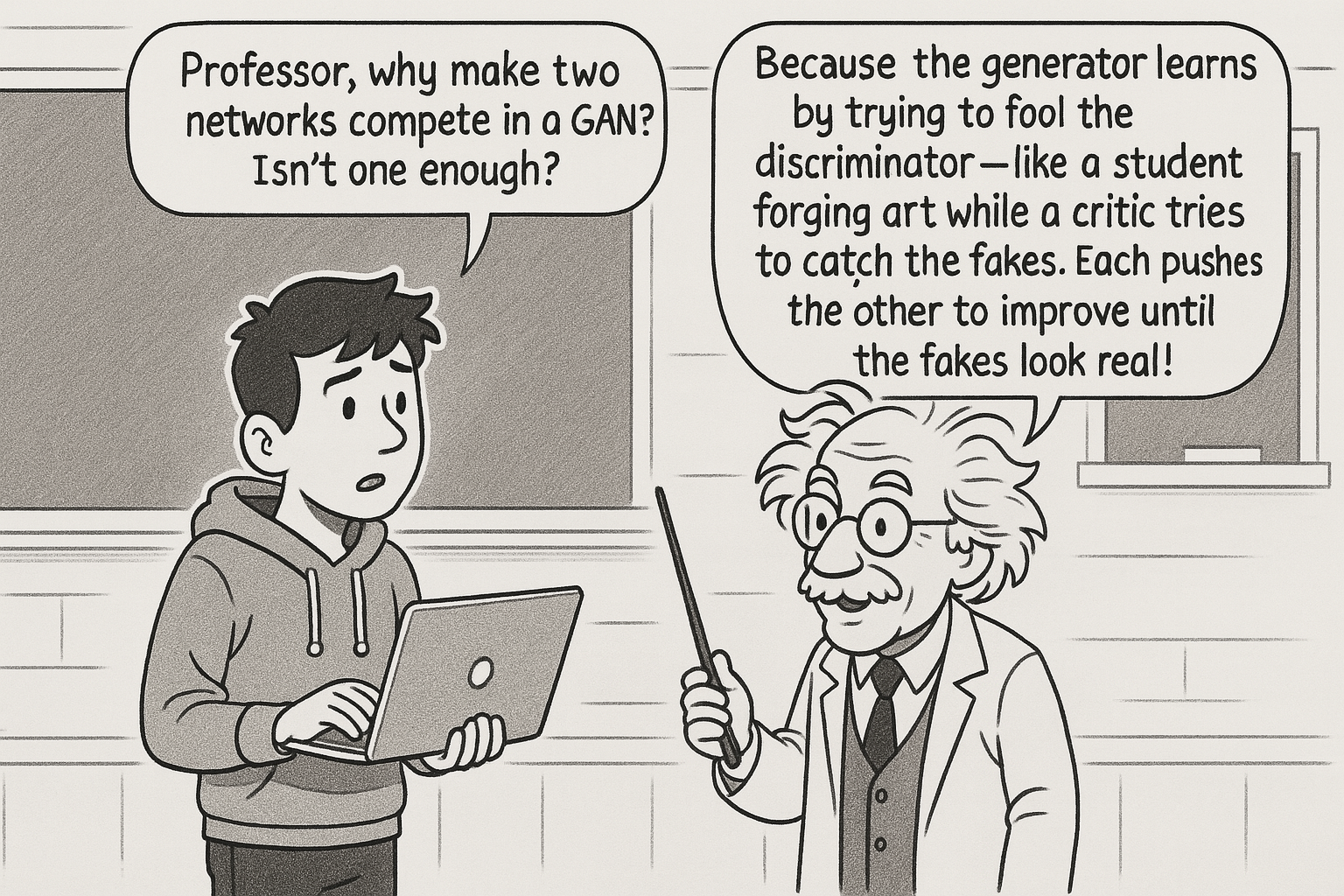Introduction
In 2014, Ian Goodfellow and his team at the University of Montreal introduced Generative Adversarial Networks (GANs) in their paper "Generative Adversarial Nets." This framework fundamentally changed how we approach generative modelling by introducing a novel adversarial training process. Instead of trying to explicitly model complex probability distributions, GANs pit two neural networks against each other in a competitive game, where one network learns to generate realistic data while the other learns to detect fake data.
"Competition between two neural networks in an adversarial game drives both towards excellence in their opposing objectives."
Core Ideas
The brilliance of GANs lies in their elegantly simple yet powerful architecture consisting of two neural networks locked in perpetual competition. The Generator network (G) takes random noise as input and transforms it into synthetic data that resembles real training data. The Discriminator network (D) acts as a critic, attempting to distinguish between real samples from the training dataset and fake samples produced by the generator.
The training process follows a minimax game formulation where both networks have opposing objectives. The generator tries to maximise the probability of fooling the discriminator, while the discriminator tries to maximise its accuracy in detecting fake samples. This adversarial relationship is mathematically expressed as a value function that both networks optimise in opposite directions.
The theoretical foundation proves that when both networks have sufficient capacity and training time, the generator will eventually learn to perfectly replicate the true data distribution. At this optimal point, the discriminator becomes unable to distinguish between real and generated samples, outputting a probability of 0.5 for all inputs.
Unlike previous generative models that required complex inference procedures or Markov chain sampling, GANs can generate new samples through simple forward propagation. This eliminates the computational overhead associated with traditional approaches and makes the generation process much more efficient.
Breaking Down the Key Concepts
Think of GANs as a counterfeiter versus police scenario that Goodfellow famously used to explain the concept. The counterfeiter (generator) starts by producing obviously fake currency notes. The police (discriminator) can easily spot these fakes and provides feedback about what makes them obviously counterfeit. Using this feedback, the counterfeiter improves their technique and produces better fakes.
This cat-and-mouse game continues iteratively. As the counterfeiter gets better at making convincing fakes, the police become more skilled at spotting subtle differences. Eventually, if both parties have unlimited resources and time, the counterfeiter becomes so skilled that even expert police cannot distinguish the fake notes from real ones.
In machine learning terms, the random noise fed to the generator is like the raw materials the counterfeiter uses. The generator learns to transform this noise into realistic-looking data through the adversarial training process. The discriminator, meanwhile, learns increasingly sophisticated features that help distinguish real from fake data.
The minimax game formulation ensures that neither network can become complacent. If the generator becomes too good too quickly, the discriminator adapts to catch up. If the discriminator becomes too powerful, it provides stronger gradients that help the generator improve. This dynamic balance drives both networks towards better performance.

Results and Significance
The paper demonstrated GANs' effectiveness across multiple datasets including MNIST handwritten digits, Toronto Face Database, and CIFAR-10 images. The generated samples showed remarkable quality for 2014 standards, appearing realistic and diverse without simply memorising training examples. The authors verified this by showing that generated samples were not merely copies of nearest neighbours from the training set.
The GAN framework spawned countless applications including image synthesis, style transfer, data augmentation, and even deepfake technology. Major tech companies and startups across the world have leveraged GAN variants for everything from creating synthetic training data to generating realistic avatars for gaming and virtual reality applications.
The conceptual breakthrough was equally significant. GANs introduced the idea that competition between neural networks could drive learning, inspiring research into adversarial training beyond just generative tasks. This influenced areas like adversarial examples in security, domain adaptation, and robust machine learning.
The paper's impact on the field cannot be overstated. It essentially created the entire subfield of adversarial machine learning and established generative modelling as a major research area. Modern text-to-image models, video generation systems, and even large language models trace their conceptual roots back to the adversarial training principles introduced in this work.
Original paper can be found here - https://arxiv.org/pdf/1406.2661